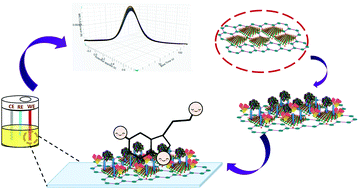Hierarchical structure of molybdenum disulfide-reduced graphene oxide nanocomposite for the development of a highly efficient serotonin biosensing platform†
Abstract
In the present work, we report a rapid, label-free and efficient immunosensor based on a hierarchical structure of molybdenum disulfide-reduced graphene oxide nanocomposite (nMoS2–rGO) for the serotonin detection. We used one-step hydrothermal method to synthesize the hierarchical structure of MoS2–rGO nanocomposite and further functionalized it using 3-aminopropyl triethoxy silane (APTES). Subsequently, the covalent conjugation of the monoclonal antibodies (anti-serotonin) onto the APTES/nMoS2–rGO/ITO electrode was carried out via EDC-NHS coupling chemistry and bovine serum albumin (BSA) was used to block non-specific binding sites onto the electrode surface. The structural and morphological properties of the synthesized nanocomposite and fabricated electrodes were studied using X-ray diffraction, scanning electron microscopy, transmission electron microscopy and Fourier transform infrared spectroscopy. The response studies on the fabricated BSA/anti-serotonin/APTES/nMoS2–rGO/ITO immunoelectrode revealed remarkable sensitivity of 10 μA log(nM)−1 cm−2, wider linear dynamic range from 1 nM to 5000 nM, excellent lower limit of detection (LOD) of 1 nM with stability up to eight weeks. The analytical performance of the fabricated immunosensor was validated via serotonin-spiked sera samples and the obtained results showed a good correlation with the response of standard serotonin solutions.



 Please wait while we load your content...
Please wait while we load your content...